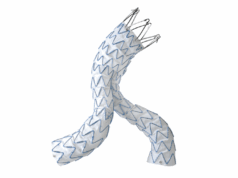
Results from the multicenter, retrospective ODYSSEUS study carried out in The Netherlands suggest that less frequent surveillance after endovascular aneurysm repair (EVAR) may be warranted. However, authors Anna C. M. Geraedts, MD, of Amsterdam University Medical Centres, Amsterdam, The Netherlands, and colleagues stress that future studies are needed to determine the patient groups in which this would be safe.
The study, recently published in the European Journal of Vascular and Endovascular Surgery (EJVES), highlighted the fact that discontinued imaging surveillance post-EVAR is common in The Netherlands. It also shows that discontinued yearly follow-up in patients with initial postoperative computed tomography angiogram (CTA) without abnormalities is not associated with poor outcomes.
“EVAR has become the predominant modality for the treatment of infrarenal abdominal aortic aneurysms (AAA) in The Netherlands,” the authors write, adding that lifelong surveillance is recommended following the procedure. However, they also note that there are concerns regarding the long-term durability of EVAR, lifelong follow-up routines, and adherence to surveillance programs. This study, therefore, aimed to examine the association between adherence to postoperative surveillance and survival and secondary interventions in patients with an initial postoperative CTA without abnormalities.
Between 2007 and 2012, all consecutive patients undergoing EVAR for intact AAA in 16 hospitals were identified retrospectively, the authors write, noting that patients were followed up until December 2018.
Geraedts et al specify that patients were included if the initial postoperative CTA showed no type I–III endoleak, kinking, infection, or limb occlusion. Primary outcomes were aneurysm-related mortality and secondary interventions, and secondary outcome was all-cause mortality.
Of the 1,596 patients included in the study, the authors report that cumulative aneurysm-related, overall, and intervention-free survival was 99.4/94.8/96.1%, 98.5/72.9/85.9%, and 96.3/45.4/71.1% at one, five, and 10 years, respectively. They note that American Society of Anesthesiologists (ASA) classification (ASA IV hazard ratio [HR], 3.810; 95% confidence interval [CI], 1.296–11.198), increase in AAA diameter (HR, 3.299; 95% CI, 1.408–7.729), and continued follow-up (HR, 3.611; 95% CI, 1.780–7.323) were independently associated with aneurysm-related mortality. The same variables and age (HR, 1.063 per year; 95% CI, 1.052–1.074) were significantly associated with all-cause mortality, the authors add.
In terms of secondary interventions, Geraedts and colleagues relay that no differences were observed between patients with continued versus discontinued follow-up (89/552; 15% vs. 136/1,044; 13%; p=0.091).
Writing in EJVES, the authors acknowledge various limitations of their study, including its retrospective, observational study design. This carries a risk of information bias, they state, noting for example that “it was unclear if patients were lost to follow-up, if imaging studies had been discontinued after uncomplicated surveillance, or if patients had undergone imaging surveillance elsewhere.”
Furthermore, they recognize that the inclusion of patients until only 2012 limits the ability to draw conclusions from more recent devices, there were no clear protocols as to when a patient might be discharged from further follow-up, there was missing information on cause of death, and also the fact that reasons why patients were no longer under surveillance were not noted.
Despite these limitations, Geraedts et al also highlight some notable strengths of the research such as the use of population-based data with long-term follow-up and the accuracy of verifying deaths through the National Death Register. In addition, they note that the investigation comprises all imaging studies made following EVAR, and “thus provides a complete overview of national practice and adherence to the ESVS [European Society for Vascular Surgery] guidelines.”
Geraedts and colleagues conclude that “discontinued follow-up is not associated with poor outcomes,” noting however that “future prospective studies are indicated to determine in which patient groups follow-up can be safely reduced.”












